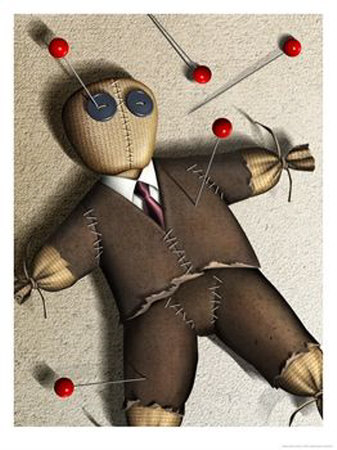 A few days ago a reader sent in a really bad BBC article about French President Nicolas Sarkozy threatening to sue a company for selling a "voodoo doll" using his image. The piece was mostly a snarky take-down of Sarkozy and his other attempts at litigation and included this sort of laughable throwaway paragraph at the end:
A few days ago a reader sent in a really bad BBC article about French President Nicolas Sarkozy threatening to sue a company for selling a "voodoo doll" using his image. The piece was mostly a snarky take-down of Sarkozy and his other attempts at litigation and included this sort of laughable throwaway paragraph at the end:
Voodoo has become associated with zombies and sticking pins into dolls to curse an enemy, but practitioners say this misrepresents their religion.
Okay, then. By comparison, MSNBC did a better job with the story. It uses the Sarkozy doll as a hook to talk about misconceptions of Voodoo.
It is unlikely that the publisher or Sarkozy have thought much about voodoo's ancient roots during the doll fiasco, but the practice is in fact just one insignificant part of a complex belief system that makes up the mysterious religion, which is still practiced in many parts of Africa, Haiti, Jamaica and Louisiana, among others.
The story has tons of information, but it's mostly just paragraph after paragraph of assertions without any sourcing. It would be nice to know where the reporter was getting the information and whether there are variances within Voudon.
Anyone can become possessed by spirits, who offer help to the living in the form of good fortune and protection from evil, according to voodoo myths. Voodoo priests guide the interaction between the living and the dead, and can call upon certain spirits depending on the community's need, it is believed. . . .
Once spread throughout the Caribbean, the southeastern United States and parts of South America, displaced Africans felt a common thread through voodoo, though the religion morphed to include elements of Christianity to appease Catholic slaveholders.
I'm wondering why the use of the word "myths" in the first paragraph and am wondering why Catholic slaveholders are singled out here.
There is some helpful information about the use of dolls, though:
It's that mysterious element of the religion that allows black magic myths such as the use of voodoo dolls to proliferate in popular culture, experts say.
In actuality, voodoo dolls were unheard of or very rare in Africa and Haiti, and had only a small surge in popularity when voodoo migrated from Haiti to New Orleans in the early 1900s. Even then, the dolls were often used for benevolent purposes, such as helping an infertile couple conceive. The concept of pinpricking-for-pain style voodoo dolls is mostly a product of Hollywood
Again, though, there are a dozen paragraphs with no sources cited. Unless the author of the piece is writing from their own expertise, that's just not acceptable.
